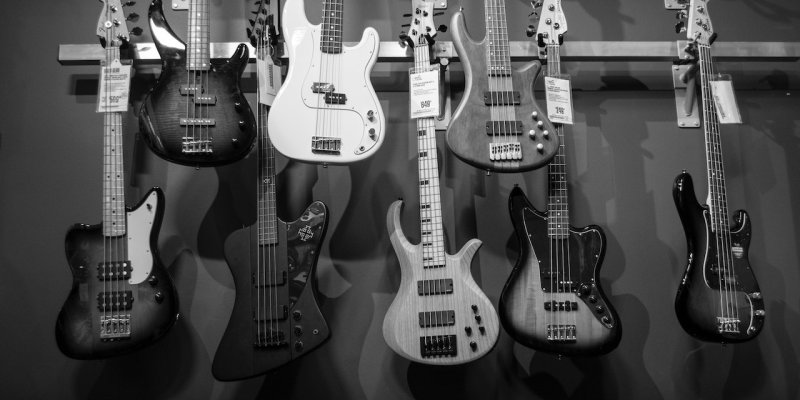
This can be somewhat of a trick question because all basses aren't made the same. The most common type of bass you will find has four strings that play the following notes: E, A, D, and G.
These also happen to correspond with the lowest four strings on a regular guitar, but they are played an octave lower on a bass.
But some basses have five or six strings that allow a bass player to expand their range. Some have less or much more than that, so there is no one correct amount of strings for a bass to have. Most people don't realize how flexible the bass guitar can be!
A bass with five strings has an added low B string that players can access for even deeper and richer playing. Keep in mind that you can also tune a bass within a few notes to reach lower notes than B if it's needed for your song selections.
Related Post: How To Write A Bass Line That Elevates A Song
A bass with six strings includes the added lower B and a higher C string.
This especially comes in handy for bass players that love to pull out a solo to reach several different higher and lower notes than usual while performing complicated riffs and embellishments.
This is often found in rock music genres, including heavy metal and glam rock. You will also find this extension of range a great fit for jazz bassists.
Rare yet easy-to-find basses can have three strings or twelve strings. The amount can really be anything as long as it makes sense to attempt to play (you won't find a bass with 100 strings, for example).
As you can imagine, a bass with 6-12+ strings would allow for some really amazing solos and flexibility for a bassist. On the other hand, a bass with three strings would work well for beginners who don't need access to a ton of notes.
Related Post: Is Bass Easier To Learn Than The Guitar? Breaking Down Both Sides
The electric bass guitar is modeled after the double bass that you will often find in orchestras, which also only has four strings. Surprisingly, the first models in the mid-1500s had five strings, and models in the 1700s had three strings.
Leo Fender and George Fullerton were among the first to develop and produce bass guitars as the genre of rock was exploding around the 1950s. Before the electric bass was made, heavy and bulky double basses were the most popular bass instruments.
Basses are the instruments that hold chords played by instruments like the guitar, piano, and strings together. These higher melodic instruments often play solo melody lines and chords, while chords are rarely played on the bass.
For this reason, they often have fewer strings than a regular guitar. The bass also doubles as a rhythmic instrument at times as well, so the focus is not on stacking notes with basses.
Related Post: How Many Strings Does A Violin Have? (+ More Facts)
Famous bassists, including Reginald Arvizu, Nathan East, Tom Peterson, and Jeff Ament, were known to play with more than four strings and sound amazing while doing so.
Many of the musicians who experimented with an increase of strings like this exploded in the music scene around the 1970s.
They are often referred to as extended-range bass players. Popular bassist and Youtuber Charles Berthoud demonstrate just how full and vibrant a 12-string bass can sound in the video above!
As you can imagine, more strings do present more of a challenge for bass players. Beginners would do well to start with the standard 4-string bass and experiment with other string amounts once they get a good feel for fewer strings.
When you add more strings to the mix, the distance between them shrinks, making it harder to play smoothly without errors.
This is especially true for performing tricks like a slap bass approach. The wider neck on a bass guitar with more than four strings also takes some practice to get accustomed to.
Related Post: Jokes And Puns About The Guitar

As a session singer, writer, and producer that has worked with over 300 clients to provide high-quality jingles, singles, and features, Yona spends her time creating and marketing new music and helpful resources for creators. Check out Yona’s latest releases on her Spotify, her Youtube and share if you like it!
If you are in need of singer, songwriter or song producer services, see what Yona Marie can offer you on her services page.